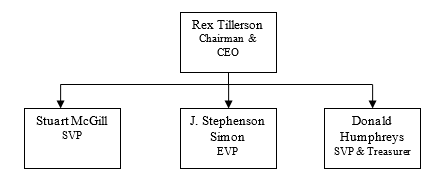The Exxon Mobil Corporation is an Oil and Gas Industry based company. The company became the largest company in the world, in terms of its revenue, after the merger between the two companies Exxon and Mobil. The company is also the largest publicly owned company with a market capitalization worth $501.17 billion, as recorded in April 2008. The company also ranks as the company having the highest recorded net income in the world for a publicly owned company.
The company has operating divisions which are divided into four segments. These pertain to upstream division, downstream division, chemical division, and global service division. The upstream division has included operations that are specific to exploration, development, production, research, and marketing for the Gas and Power Company. The operations for the downstream division include oil refining, supply management, marketing of fuels, and management of other products like lubricants.
The Chemical division mainly handles the operations relating to the Exxon Mobil Chemical Company. The global service operations for Exxon Mobil include service management specific to information technology, real estate, and related facilities, procurement management, and business support centers for the customers of the company.
The sales strategy for any company is a long-term vision and a plan of action that is employed by the company to manage the sales of the products. The key elements of the sales strategy include the goals and objectives of the company pertaining to the sales function, identification of the marketplace and the target market, identification of the competitors of the company in the industry, and the channels employed to market and sell the products to the customers.
The positioning strategy of the business is also incorporated in the sales strategy. The sales strategy that is employed by Exxon Mobil differs for the different products produced, managed, and sold by the company. The main sales strategy that is used at the company is aimed at optimizing sales as a result of the increase in the demand for oil and oil-based products like lubricants in the market. (‘TonenGeneral Sekiyu,’ 2008).
The sales strategy has been changed for the distributors and the sales managers to focus on the selling of solutions to customers instead of selling products to the customers in the market. The company has developed strategic sales plans which target the top-line sales growth amongst the distributors of Exxon Mobil distributors. The channels that are used for promoting sales include integrated brand marketing with placements of TV, print ads in magazines and newspapers, point of purchase placement of marketing material as well as promotional events based on the NASCAR and Indy championships.
Additionally, the company has also employed a tour for encouraging and establishing favorable public relations for the company. Additionally, a credit card-based sales promotion was also employed by the company in 2005. The “90-day credit-card promotion resulted in more than 80,000 new cardholders for the proprietary ExxonMobil credit card. A majority of the new cardholders took advantage of the opportunity to also get a free Speedpass upon acceptance. Beginning in March and running through the end of May, each new account received a $10 statement credit after the first use of the card.” (‘ExxonMobil promotion nets 80,000 new cardholders’, 2005)
The following organizational chart available at CogMap depicts the top management at the company. The chairman and CEO of the company are Rex Tillerson, who is followed in the hierarchy by Stuart McGill, SVP, J. Stephenson Simon, the executive vice president and Donald Humphreys, the SVP and Treasurer for the company. The number of sales personnel at the company cannot be determined as the scale of the operation of the company is very large and in multiple locations all over the world. However it has been determined that the sales personnel present in the company are in large numbers, above 500 people.

The sales revenue that was recorded in 2007 for the Exxon Mobile Corporation was one of the highest revenues ever recorded. The company has a sales & operating revenue of $390,328 million and a net income of $40,610 million. The cost of sales for the company for 2007 amounted to $ 232,852 million (‘ExxonMobil Annual Report 2007, 2008). The predications made by the corporate giant Exxon Mobil for its sales operations in 2009 have been significantly understated by the company.
The company has provided that the projected sales in the year 2009 will be much lower than that experienced in 2007. This is largely due to the crashing economy and the automobile market hitting rock bottom which has effected the consumption of lubricants and gas, especially in North America. “While after-tax operating earnings rose 1.6% in 2007 to $40 billion, or $7.20 per share, we see full-year 2008 operating earnings rising 16% to $46.6 billion, or $8.55 per share, before moderating to a 1% increase in 2009 to $8.63 per share.” (‘ExxonMobil: A Big Opportunity in Big Oil’, 2008)
The direct customers of the Exxon Mobil Corporation are the retailers and the distributors in the market. The main product of the company pertains to oil, gas, petroleum based products and lubricants. These are dispersed in the market through the distributors and the retailers in the market which form the direct customers. The end users of the products by Exxon Mobil however include the mass consumers of auto lubricants, and the gas consumer in the market.
References
(2005), ExxonMobil promotion nets 80,000 new cardholders, National Petroleum News, Vol. 97 Issue 9, p46-46, 1/4p. Web.
(2008), ExxonMobil: A Big Opportunity in Big Oil. Web.
(2008), ExxonMobil Annual Report 2007. Web.
(2008), Exxon Mobil Corporation, CogMap. Web.
TonenGeneral Sekiyu, K.K, (2008), Business Strategy and 2007 Financial Results, TSE Arrows. Web.